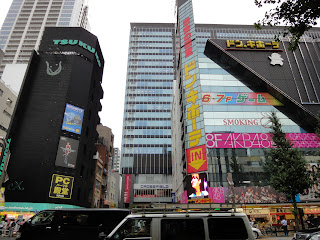Akihabara is a famous shopping area in Japan for electronic, computer, anime, and otakuchōme. New parts for PC-building are readily available from a variety of stores. Tools, electrical parts, wires, microsized cameras and similar items are found in the cramped passageways of Soto Kanda 1-chōme (near the station). Foreign tourists tend to visit the big name shops like Laox or other speciality shops near the station, though there is more variety and lower prices at locales a little further away. Akihabara gained some fame through being home to one of the first stores devoted to personal robots and robotics.
 The area was just out of Sujikai-gomon city gate (present Mansei bridge) which was one of the city gates (Mitsuke) of old Edo (Tokyo). It was the gateway from inner Edo to northern and northwestern Japan and Kan’ei-ji temple in Ueno. You can read "HOW TO REACH AKIHABARA" for more details.
The area was just out of Sujikai-gomon city gate (present Mansei bridge) which was one of the city gates (Mitsuke) of old Edo (Tokyo). It was the gateway from inner Edo to northern and northwestern Japan and Kan’ei-ji temple in Ueno. You can read "HOW TO REACH AKIHABARA" for more details.
Many dealers, craftsmen and relatively lower class samurai lived there. Hundreds of electronics shops, ranging from tiny one man stalls specializing in a particular electronic component to large electronics retailers, line the main Chuo Dori street and the crowded side streets around Akihabara. They offer everything from the newest computers, cameras, televisions, mobile phones, electronics parts and home appliances to second-hand goods and electronic junk.
A few chain stores, such as Sofmap, Ishimaru and Laox, each operate multiple specialized branches along the main roads, while small independent shops can be found in the side streets. The only mega sized store is the Yodobashi Camera
Note that some of the electronics on sale are only intended for use in Japan due to voltage and other technical differences, Japanese language documentation and limited warranties. However, several stores also feature a selection of international models intended for overseas use, and most also offer duty free shopping to foreign tourists on purchases of over 10,000 yen (passport required). goods, including new and used items. New items are mostly to be found on the main street, Chūōdōri, with many kinds of used items found in the back streets of Soto Kanda 3- complex on the east side of the station.
After shopping is completed, there are many restaurants and street side food stalls to hang out, like the below one.
 The area was just out of Sujikai-gomon city gate (present Mansei bridge) which was one of the city gates (Mitsuke) of old Edo (Tokyo). It was the gateway from inner Edo to northern and northwestern Japan and Kan’ei-ji temple in Ueno. You can read "HOW TO REACH AKIHABARA" for more details.
The area was just out of Sujikai-gomon city gate (present Mansei bridge) which was one of the city gates (Mitsuke) of old Edo (Tokyo). It was the gateway from inner Edo to northern and northwestern Japan and Kan’ei-ji temple in Ueno. You can read "HOW TO REACH AKIHABARA" for more details.Many dealers, craftsmen and relatively lower class samurai lived there. Hundreds of electronics shops, ranging from tiny one man stalls specializing in a particular electronic component to large electronics retailers, line the main Chuo Dori street and the crowded side streets around Akihabara. They offer everything from the newest computers, cameras, televisions, mobile phones, electronics parts and home appliances to second-hand goods and electronic junk.
A few chain stores, such as Sofmap, Ishimaru and Laox, each operate multiple specialized branches along the main roads, while small independent shops can be found in the side streets. The only mega sized store is the Yodobashi Camera
Note that some of the electronics on sale are only intended for use in Japan due to voltage and other technical differences, Japanese language documentation and limited warranties. However, several stores also feature a selection of international models intended for overseas use, and most also offer duty free shopping to foreign tourists on purchases of over 10,000 yen (passport required). goods, including new and used items. New items are mostly to be found on the main street, Chūōdōri, with many kinds of used items found in the back streets of Soto Kanda 3- complex on the east side of the station.
After shopping is completed, there are many restaurants and street side food stalls to hang out, like the below one.















































